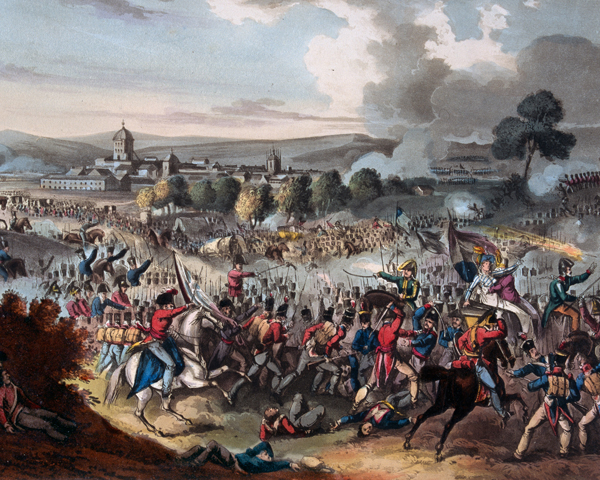Origins
In December 1755, a new regiment was raised in northern England under the colonelcy of William Whitmore. Initially numbered the 55th Foot, it became the 53rd the following year when two of the intervening regiments disbanded.
By then, the unit was stationed in Gibraltar, sometimes serving as marines during the Seven Years War (1756-63). It remained there until 1768, when it moved to Ireland.
It joined the American War of Independence (1775-83) in 1776, serving at Quebec (1776) and Fort Ticonderoga (1777). It also served during the Saratoga campaign (1777), where its flank companies were captured and interned for the rest of the war. The remainder of the 53rd took part in raids from British-held Quebec into New York and Vermont in 1778-80.
In 1782, the regiment was assigned to the county of Shropshire. It returned to Britain the following year.
French wars
During the French Revolutionary Wars (1793-1802), it fought in the Netherlands and France, seeing action at Valenciennes (1793), Dunkirk (1793), Nieuport (1793) and Tournay (1794). In 1795, it moved to the West Indies for seven years, serving on St Vincent, Trinidad and St Lucia.
In 1803, a 2nd Battalion was raised in Sunderland. Initially stationed in England and Ireland, it was sent to the Peninsular War (1808-14) in 1809, fighting at Talavera (1809), Salamanca (1812) and Burgos (1812).
By December 1812, the battalion had suffered such high casualties that four of its companies had to merge with four from the 2nd Regiment of Foot to form the 2nd Provisional Battalion. This went on to fight at Vitoria (1813), San Sebastian (1813), Sorauren (1813) and Nivelle (1813).
In the meantime, six cadre companies from the 53rd’s 2nd Battalion had returned home to re-recruit. It was able to reform in March 1814 and returned to the Peninsula, fighting at Toulouse (1814).
Following occupation duties in France, 2nd Battalion returned to Britain and Ireland before becoming the first troops to guard Napoleon during his exile on St Helena. In 1817, the battalion returned home and was disbanded.
India
Meanwhile, in 1805, 1st Battalion had been sent on the regiment’s first posting to India. While there, it fought during the Bundelkhand campaign (1809-10) and the Nepal War (1814-16). It then took part in the Third Maratha War (1817-18), before returning to Britain in 1823.
The 53rd carried out garrison duties at home and on Gibraltar and Malta until 1844, when it returned to India. This time, it fought during the First Sikh War (1845-46), at Aliwal (1846) and Sobraon (1846). It was also present at the decisive Battle of Gujerat (1849) during the Second Sikh War (1848-49).
Following service on the North West Frontier, the regiment fought during the Indian Mutiny (1857-59), taking part in the Relief of Lucknow (1857), the Battle of Cawnpore (1857) and the Capture of Lucknow (1858). During this campaign, the 53rd won five Victoria Crosses.
The regiment returned to Britain in 1860. Its final independent overseas postings were to Canada (1860-66) and Bermuda (1869-75).
Legacy
It was back in Britain by 1881, when it merged with the 85th (The King's) Regiment of Light Infantry (Bucks Volunteers) to form The King’s Light Infantry (Shropshire Regiment).
Regimental museums
The National Army Museum works with a network of Regimental and Corps Museums across the UK to help preserve and share the history and traditions of the Army and its soldiers.
Discover more about the 53rd (Shropshire) Regiment by visiting the Soldiers of Shropshire Museum at Shrewsbury Castle.












